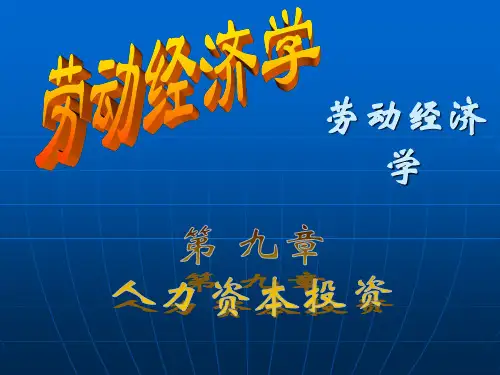- 1、下载文档前请自行甄别文档内容的完整性,平台不提供额外的编辑、内容补充、找答案等附加服务。
- 2、"仅部分预览"的文档,不可在线预览部分如存在完整性等问题,可反馈申请退款(可完整预览的文档不适用该条件!)。
- 3、如文档侵犯您的权益,请联系客服反馈,我们会尽快为您处理(人工客服工作时间:9:00-18:30)。
First Hicks-Marshall Law
Own-wage elasticity of demand is
relatively high when the price elasticity of demand for the final product is relatively high. This works through the scale effect:
the price elasticity of demand for the
final product is relatively high, it is relatively easy to substitute other factors for this category of labor,
Elasticity and Slope
Slope involves a relationship between
the change in the level of the wage and a change in the level of employment. Elasticity involves a relationship between percentage changes in these variables. A constant change in the level of a variable will not result in a constant percentage change in that variable.
Elasticity and Slope
Note, for example that:
an increase from 1 to 2 is a 100% increase, an increase from 2 to 3 is a 50% increase,
an increase from 3 to 4 is a 33% increase,
the substitution effect is larger, and/or
the scale effect is larger
Hicks-Marshall Laws of Derived Demand
Own-wage elasticity of labor demand is relatively high when:
an increase from 4 to 5 is a 25% increase, an increase from 10 to 11 is a 10% increase,
and an increase from 100 to 101 is a 1% increase.
Elasticity Along a Linear Demand Curve
Note, for example that:
an increase from 1 to 2 is a 100% increase, an increase from 2 to 3 is a 50% increase,
an increase from 3 to 4 is a 33% increase,
Second Hicks-Marshall Law
Own-wage elasticity of labor demand will
be relatively high when it is relatively easy to substitute other factors for this category of labor.
Elasticity and Slope
Note, for example that:
an increase from 1 to 2 is a 100% increase,
Elasticity and Slope
Note, for example that:
an increase from 1 to 2 is a 100% increase, an increase from 2 to 3 is a 50% increase,
an increase from 4 to 5 is a 25% increase,
Elasticity and Slope
Note, for example that:
an increase from 1 to 2 is a 100% increase, an increase from 2 to 3 is a 50% increase,
the price elasticity of demand for the
final product is relatively high,
Hicks-Marshall Laws of Derived Demand
Own-wage elasticity of labor demand is relatively highws of Derived Demand
Own-wage elasticity of labor demand is relatively high when:
the price elasticity of demand for the
final product is relatively high, tt is relatively easy to substitute other factors for this category of labor, the supply of other factors of production is relatively elastic, and this category of labor accounts for a
Elasticity Along a Linear Demand Curve
Elasticity and Slope Comparisons
Determinants of Own-wage Elasticity of Labor Demand
Labor demand will be more elastic when:
Hicks-Marshall Laws of Derived Demand
Own-wage elasticity of labor demand is relatively high when:
the price elasticity of demand for the
final product is relatively high, it is relatively easy to substitute other factors for this category of labor, the supply of other factors of production is relatively elastic,
Higher wages result in higher average and
marginal costs, Higher costs result in a higher product price, Higher prices result in a reduction in the quantity of the product demanded, A reduction in sales results in a reduction in output and in input use.
an increase from 3 to 4 is a 33% increase,
an increase from 4 to 5 is a 25% increase, an increase from 10 to 11 is a 10% increase,
Elasticity and Slope
Elasticity and Slope
Note, for example that:
an increase from 1 to 2 is a 100% increase, an increase from 2 to 3 is a 50% increase,
an increase from 3 to 4 is a 33% increase,
Second Hicks-marshall Law
Own-wage elasticity of labor demand will
be relatively high when it is relatively easy to substitute other factors for this category of labor. This law works through the substitution effect.
Fourth Hicks-Marshall Law
Own-wage elasticity is relatively large
when this category of labor accounts for a relatively large share of total costs This law works through the scale effect:
Chapter 4: Labor Demand Elasticities
Own-wage Elasticity of Labor Demand
Own-wage Elasticity of Labor Demand
Labor demand is said to be:
Elasticity and Slope
Slope involves a relationship between
the change in the level of the wage and a change in the level of employment. Elasticity involves a relationship between percentage changes in these variables.








